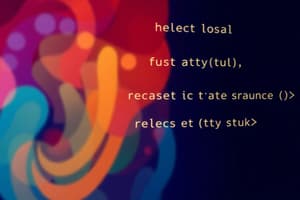Podcast
Questions and Answers
What is the primary purpose of functions in JavaScript?
What is the primary purpose of functions in JavaScript?
- To declare variables with global scope.
- To create objects with properties and methods.
- To define HTML elements dynamically.
- To organize and reuse code blocks. (correct)
Function declarations in JavaScript are not hoisted, meaning you cannot call them before they appear in your code.
Function declarations in JavaScript are not hoisted, meaning you cannot call them before they appear in your code.
False (B)
What keyword is used to declare a function in JavaScript?
What keyword is used to declare a function in JavaScript?
function
In JavaScript, values passed to a function when it is invoked are called ______.
In JavaScript, values passed to a function when it is invoked are called ______.
Match the following:
Match the following:
Which of the following best describes function parameters in JavaScript?
Which of the following best describes function parameters in JavaScript?
The order of arguments passed to a function does not need to match the order of parameters defined in the function declaration.
The order of arguments passed to a function does not need to match the order of parameters defined in the function declaration.
What is the purpose of the return statement in a JavaScript function?
What is the purpose of the return statement in a JavaScript function?
When a function encounters a ______ statement, it immediately stops executing.
When a function encounters a ______ statement, it immediately stops executing.
What is variable scope in JavaScript?
What is variable scope in JavaScript?
Variables declared inside a function have global scope by default.
Variables declared inside a function have global scope by default.
Name the two primary scopes in JavaScript.
Name the two primary scopes in JavaScript.
Variables declared with ______ and const have block scope.
Variables declared with ______ and const have block scope.
What is the key difference between var and let in terms of scope?
What is the key difference between var and let in terms of scope?
Arrow functions in JavaScript automatically capture the value of 'this' from their enclosing context.
Arrow functions in JavaScript automatically capture the value of 'this' from their enclosing context.
What is the syntax for a simple arrow function with no parameters that returns the string "Hello, world!"?
What is the syntax for a simple arrow function with no parameters that returns the string "Hello, world!"?
In an arrow function, if you have only one parameter, you can omit the ______.
In an arrow function, if you have only one parameter, you can omit the ______.
Which of the following is NOT a typical use case for arrow functions?
Which of the following is NOT a typical use case for arrow functions?
Callback functions are executed immediately after they are passed as arguments to another function.
Callback functions are executed immediately after they are passed as arguments to another function.
What is a "callback function"?
What is a "callback function"?
A callback function that doesn't have a name is called an ______ callback function.
A callback function that doesn't have a name is called an ______ callback function.
Which of the following is a fundamental aspect of callback functions?
Which of the following is a fundamental aspect of callback functions?
Global variables are automatically accessible within functions, without needing to be passed as arguments.
Global variables are automatically accessible within functions, without needing to be passed as arguments.
What is the term for variables that are only accessible within the function they are defined in?
What is the term for variables that are only accessible within the function they are defined in?
Using ______ and const promotes more precise control over variable scope and reduces issues associated with hoisting.
Using ______ and const promotes more precise control over variable scope and reduces issues associated with hoisting.
What is the primary benefit of using arrow functions over traditional functions in JavaScript?
What is the primary benefit of using arrow functions over traditional functions in JavaScript?
In JavaScript, the 'callback' function is only used for the intent of operations being asynchronous.
In JavaScript, the 'callback' function is only used for the intent of operations being asynchronous.
With regards to callbacks, what does it mean when a function executes 'at a later time'?
With regards to callbacks, what does it mean when a function executes 'at a later time'?
If a function is defined without a name, then it is known as a(n) ______.
If a function is defined without a name, then it is known as a(n) ______.
Match the term with its description:
Match the term with its description:
What is one of the major use cases for callback functions?
What is one of the major use cases for callback functions?
It is impossible to pass a callback function when using an arrow function.
It is impossible to pass a callback function when using an arrow function.
In relation to variable scope, what are some of the benefits of utilizing the let keyword when declaring a function?
In relation to variable scope, what are some of the benefits of utilizing the let keyword when declaring a function?
The visibility and accessibility of code inside of a function is known as ______.
The visibility and accessibility of code inside of a function is known as ______.
In the example const add = (a, b) => a + b;, what type of function is being showcased?
In the example const add = (a, b) => a + b;, what type of function is being showcased?
If variables are declared outside of a function, then they are bound to the 'local' scope of the code body.
If variables are declared outside of a function, then they are bound to the 'local' scope of the code body.
What is the purpose of declaring an argument when creating a function in JavaScript?
What is the purpose of declaring an argument when creating a function in JavaScript?
A function can send a value back by using the ______ statment.
A function can send a value back by using the ______ statment.
Match the following keywords to their proper use:
Match the following keywords to their proper use:
Which of these keywords are fundamental in understanding variable scope?
Which of these keywords are fundamental in understanding variable scope?
Parameters are used within the calling statement, whereas arguments are used within the function definition.
Parameters are used within the calling statement, whereas arguments are used within the function definition.
Flashcards
How are functions declared in JavaScript?
How are functions declared in JavaScript?
Functions are declared using the function keyword, followed by a name, parentheses for parameters, and curly braces for the code block.
What is a JavaScript function?
What is a JavaScript function?
A block of code that can be executed when called. Functions help organize and reuse code.
What is functionName?
What is functionName?
The name of the function, used to call and refer to the function. It should be a valid identifier.
What are parameters in a function?
What are parameters in a function?
Signup and view all the flashcards
How do you call a function?
How do you call a function?
Signup and view all the flashcards
What is Function Hoisting?
What is Function Hoisting?
Signup and view all the flashcards
What are Parameters?
What are Parameters?
Signup and view all the flashcards
What are Arguments?
What are Arguments?
Signup and view all the flashcards
What are function return values?
What are function return values?
Signup and view all the flashcards
How does the return statement affect execution?
How does the return statement affect execution?
Signup and view all the flashcards
What is Variable Scope?
What is Variable Scope?
Signup and view all the flashcards
What is Global Scope?
What is Global Scope?
Signup and view all the flashcards
What is Local (Function) Scope?
What is Local (Function) Scope?
Signup and view all the flashcards
What is Block Scope?
What is Block Scope?
Signup and view all the flashcards
What are arrow functions?
What are arrow functions?
Signup and view all the flashcards
What are Callback functions?
What are Callback functions?
Signup and view all the flashcards
Passing a function as an argument
Passing a function as an argument
Signup and view all the flashcards
Execution at a Later Time
Execution at a Later Time
Signup and view all the flashcards
Signup and view all the flashcards
Signup and view all the flashcards
Study Notes
Functions in JavaScript
- Functions are fundamental to JavaScript, enabling the creation of reusable code blocks.
- They promote organization, efficiency, and maintainability in JavaScript programs.
- A function is a block of code that executes when called.
- It can have a name and accept parameters for processing input.
Function Declaration
- Functions are declared using the
functionkeyword. - Syntax:
function functionName(parameters) { // Function code here } functionkeyword declares the function in JavaScript.functionNameis the name of the function and follows the same naming rules as variables.parametersare optional, they are enclosed in parentheses, and represent values the function expects.- Function names are identifiers and are used to refer to the function.
- Function declarations are hoisted, allowing them to be called before their definition in the code.
Function Parameters
- Parameters are placeholders defined within a function's parentheses that accept input values.
- They act as local variables within function.
- Syntax:
function functionName(parameter1, parameter2, ...) { // Function code using the parameters } parameter1,parameter2, etc., are placeholders for values expected when the function is called.- Valid JavaScript identifiers should be used as parameter names.
Function Arguments
- Arguments are the actual values passed to a function when it's invoked.
- Arguments should match the number and order of the parameters defined in the function declaration.
- Syntax:
functionName(argument1, argument2, ...); argument1,argument2, etc., are the real values passed when calling the function.
Value-Returning Functions
- Functions can return values to the calling code using the
returnstatement. - The
returnstatement passes data or information from the function, serving as a result of the function's operation. - When a
returnstatement is encountered, the function stops execution immediately. - The
returnstatement syntax:return value;
Variable Scope
- Variable scope refers to the visibility and accessibility of variables within different parts of code.
- JavaScript has two primary scopes: global and local (function).
Global Scope
- Variables declared outside any function are in the global scope and can be accessed and modified from anywhere in your code, including inside functions.
Local (Function) Scope
- Variables declared inside a function are in the local scope.
- These variables can only be accessed and modified within the function they are declared.
- Each function creates its own scope, preventing naming conflicts between variables in different functions.
Block Scope (ES6 and beyond)
- Variables declared with
letandconstpossess block scope, confined to the block of code (e.g., loops, conditionals) where they are defined. - Such variables are not accessible outside their defining block.
- Function parameters exist within the local scope of the function, acting as local variables accessible only within that function.
Arrow Functions
- Arrow functions, introduced in ECMAScript 6 (ES6) provide a concise syntax, and automatically capture the value of
thisfrom the enclosing context. - Syntax:
(parameter1, parameter2, ..., parameterN) => expression - If only one parameter is provided, the parentheses can be omitted.
- The arrow (=>) signifies the definition of an arrow function.
expressionis a single expression or statement that the function executes, automatically returning the result.- Examples:
- No parameters:
const sayHello = () => "Hello, world!"; - One parameter:
const doubleNumber = (number) => { return number * 2; } - Multiple parameters:
const add = (a, b) => a + b;
- No parameters:
Callback Functions
- Callback functions are functions passed as arguments to other functions, to be executed upon specific events or condition being met.
- Passing a Function as an Argument is done in JavaScript, where a function being passed is known as a "callback."
- Execution at a Later Time happens in Receiving function which executes the callback function at specific event.
- Examples:
- Anonymous Callback Functions:
setTimeout(function() { console.log("This is a callback executed after 2 seconds."); }, 2000); - Arrow Functions as a Callback:
setTimeout(() => { console.log("This is an arrow function callback executed after 2 seconds."); }, 2000);
- Anonymous Callback Functions:
Studying That Suits You
Use AI to generate personalized quizzes and flashcards to suit your learning preferences.




